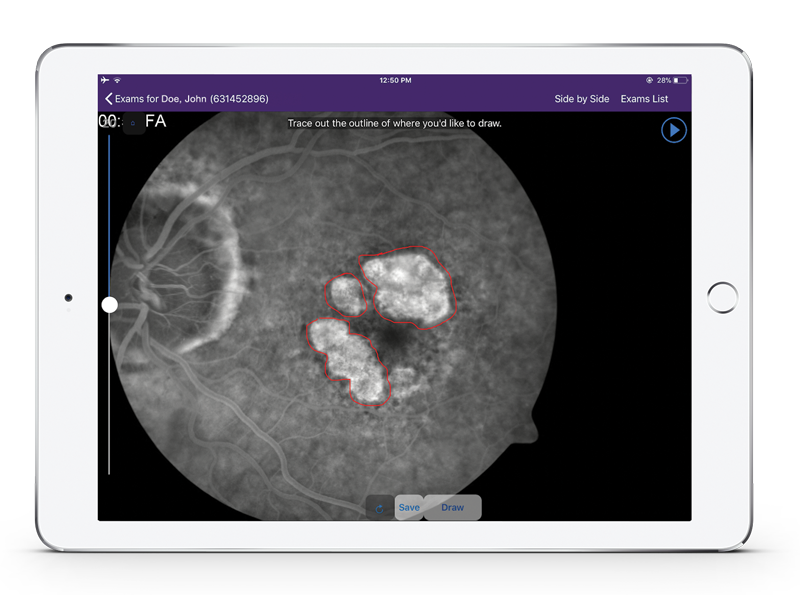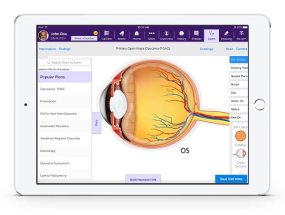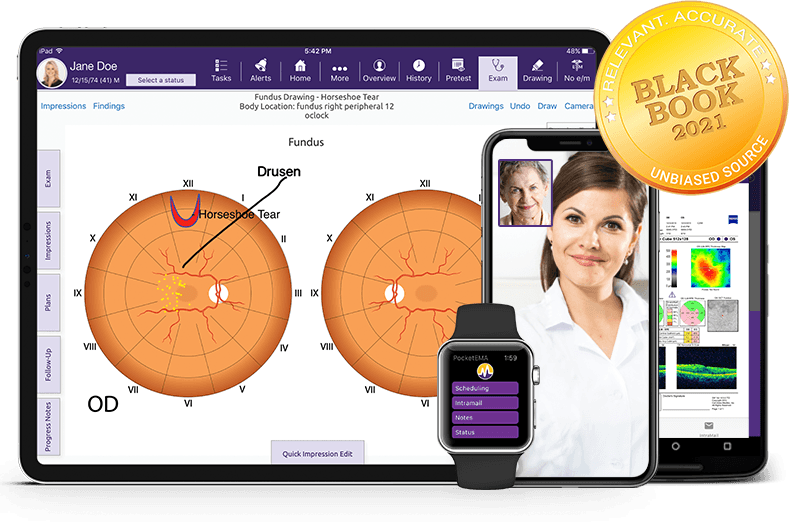What’s New in Ophthalmology?

Innovations in ophthalmology software drive transformations in the way healthcare information gets created, consumed and utilized
Looking ahead, everyone’s goals would have to include software that supports providers in delivering high-quality care, improving patient outcomes, increasing practice efficiencies and enabling practice growth.
As we strain to see the future and plan for its arrival, four major trends are coming into focus: user-experience innovations in ophthalmology software, new technology in ophthalmology image management, advancements in ophthalmology subspecialty support and greater integration of software platforms.
1. User-Experience Innovations in Ophthalmology Software
A primary focus of new technology in ophthalmology is the user experience. Streamlined interfaces are improving software for electronic health records (EHR) and practice management (PM) systems, thus helping to speed clinical workflows, save staff time and enable physicians to treat more patients in a day.
 Intuitive single-screen innovations are removing steps in the documentation process, which allows quicker editing of charts and less hunting for patient data. Further developments will enable practices not only to operate more efficiently but also to deliver more personalized care, so ophthalmologists can focus on their patients instead of their charts.
Intuitive single-screen innovations are removing steps in the documentation process, which allows quicker editing of charts and less hunting for patient data. Further developments will enable practices not only to operate more efficiently but also to deliver more personalized care, so ophthalmologists can focus on their patients instead of their charts.
Smarter software may also help practices to address challenges with reimbursement, the growing role of optometrists in the market, and an increase in patient volume as more baby boomers require eye care.
Single-screen tools to help ophthalmologists do more with less include faster follow-ups with fewer clicks, summary views of key patient data history and streamlined documentation of exams. ModMed® has updated its cloud-based ophthalmology suite with all of these capabilities.
2. New Technology in Ophthalmology Imaging
Greater integration of systems is another advance in the technology of ophthalmology, with a new focus on ophthalmic image management.
 Instead of entering patient information manually when using advanced diagnostic devices like optical coherence tomography scanners, visual fields and fundus cameras, technicians are beginning to take advantage of more automated image, diagnostic and patient data transfers.
Instead of entering patient information manually when using advanced diagnostic devices like optical coherence tomography scanners, visual fields and fundus cameras, technicians are beginning to take advantage of more automated image, diagnostic and patient data transfers.
By automatically receiving and storing industry-standard DICOM image files from diagnostic devices, together with the other data needed for clinical use, techs can routinely save several minutes on an exam — which adds up — while physicians can instantly access and compare images in charts, and offices can easily treat more patients in a day. Practices move ever closer to peak performance.
3. Advancements in Ophthalmology Subspecialties
Which innovations in ophthalmology target your specific area of expertise? Look for enhanced software support for your subspecialty workflows and analytics.
Each subspecialty requires its own EHR content, including chief complaints, diagnoses with ICD-10 codes, patient counseling and education, surgical planning, procedure notes, interpretation and operative reports, and post-op evaluations. Optimally, an EHR system would come with extensive content, curated by ophthalmologists for your subspecialty and customizable by you for your practice.
ModMed’s EHR, EMA®, charts that course. Ranked #1 among EHRs in Black Book™ surveys, EMA is intelligent, adaptive, and available via desktop, laptop, iPad and smartphone. It comes out of the box — metaphorically speaking, since it’s cloud based — with support for five subspecialties:
 Cataract and refractive physicians get tools tailored to the anterior segment workflow as well as protocols to code new diagnoses, plans, and visits such as one-day post-op cataract and LASIK.
Cataract and refractive physicians get tools tailored to the anterior segment workflow as well as protocols to code new diagnoses, plans, and visits such as one-day post-op cataract and LASIK.
Glaucoma specialists can easily see notes from previous gonioscopy, optic nerve photography, visual fields and optic nerve OCT, and quickly identify patients who have not returned for follow-up.
Oculoplastic surgeons find tools just for them, including an updated medical library. They can capture photos with iPads or smartphones, save images to charts, compare them side by side, even draw on them.
Pediatric ophthalmologists get workflows associated with treating children, and they can view key metrics on a single screen to analyze diseases efficiently.
Retina physicians get workflows for retinal diseases, including overviews of relevant testing and other key metrics on a single screen.
4. Software Integration for Ophthalmology
Integration is the theme of many new innovations in ophthalmology software. A one-stop shop — where ophthalmology EHR, PM, revenue cycle management, analytics and ancillary services all come from a single vendor — means no software bridges to troubleshoot and fewer logins to juggle. It can increase efficiencies and decrease headaches. That’s especially true when systems are cloud based, meaning there’s no server hardware to purchase, maintain and replace. Plus, the modern software-as-a-subscription model means quick scalability for new users and locations.
 Another form of integration is device independence — accessing your data not only from Windows, Mac or other desktops, but also from laptops, tablets and smartphones. That means you can practice nearly whenever and wherever you happen to be.
Another form of integration is device independence — accessing your data not only from Windows, Mac or other desktops, but also from laptops, tablets and smartphones. That means you can practice nearly whenever and wherever you happen to be.
Patient engagement tools, such as patient portals, check-in kiosks, appointment reminders and survey follow-ups, offer yet more advances in the technology of ophthalmology EHR software. These tools can help your patients be more involved in their care while instilling more trust in you, differentiating your practice from others, saving time for staff, enabling mobile health, reducing no-show rates, and increasing the number of patients you can see.
Integrated new technologies in ophthalmology go well beyond clouds and devices, to the very heart of your practice. ModMed’s ophthalmology software is designed by ophthalmologists. It’s the reason the look and feel are so intuitive and adaptive, with more tapping and less typing.
It’s why the EHR system learns how you work and suggests notes, protocols and codes, even capturing data automatically for MIPS reporting. It’s how the analytics drill down throughout your enterprise to help you make data-driven decisions.
Which diabetic patients missed their retinopathy check-ups? Which LASIK patients were evaluated but not scheduled? Which referring physicians sent the most patients? How did costs compare to benchmarks? So many answers can be right at your fingertips.
This blog is intended for informational purposes only and does not constitute legal or medical advice. Please consult with your legal counsel and other qualified advisors to ensure compliance with applicable laws, regulations and standards.